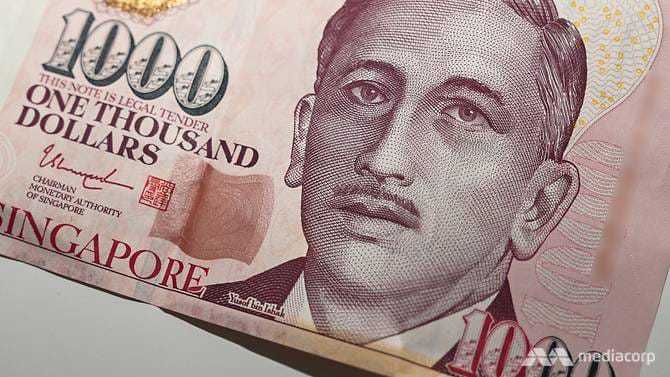MAS reduces pace of appreciation for Singdollar 'slightly' amid slow growth
14 October, 2019

The Monetary Authority of Singapore (MAS) is reducing the pace of the Singapore dollar’s appreciation “slightly”, in line with market expectations amid subdued growth and low inflation.
There will, however, be no change to the width and the level at which the Singapore dollar's nominal effective exchange rate (S$NEER) policy band is centred, it said in a statement for its semi-annual policy review on Monday (Oct 14).
“This measured adjustment to the policy stance is consistent with medium-term price stability, given the current economic outlook,” noted the central bank.
“MAS will continue to closely monitor economic developments and is prepared to recalibrate monetary policy should prospects for inflation and growth weaken significantly.”
Instead of setting interest rates, the MAS operates a managed float regime for the Singapore dollar, allowing the exchange rate to fluctuate within an unspecified policy band.
It changes the slope, width and centre of that band when it wants to adjust the pace of appreciation or depreciation of the Singapore currency.
Monday’s move marks the central bank’s first easing move since April 2016 when it flattened the S$NEER slope to zero per cent.
The MAS held on to that “neutral” stance for two years before tightening twice in 2018 to allow for “a modest and gradual” appreciation.
Amid the headwinds of trade tensions and moderating global growth, it opted to stand pat six months ago.
Since then, economists have raised their bets for MAS to loosen its exchange-rate based monetary policy this month, with all 11 economists polled by Reuters expecting a slight easing on Monday.
SLOWING GROWTH
In a separate release from the Ministry of Trade and Industry on Monday morning, the Singapore economy dodged a technical recession by growing 0.6 per cent on a quarter-on-quarter seasonally adjusted annualised basis.
This marked a recovery from the 2.7 per cent contraction in the previous quarter, but missing expectations for growth of 1.5 per cent based on 11 economists polled by Reuters.
From a year ago, growth remained tepid at 0.1 per centand also missing expectations.
In its monetary policy statement, MAS said the local economy had slowed over the first three quarters of 2019. The growth easing was more significant in the April to June quarter, as the cumulative effect of trade tariffs and elevated policy uncertainty took a heavier toll on manufacturing and trade.
It added that there are “nascent signs” that the downturn could spill over into domestic demand in some of Singapore’s major trading partners in the quarters ahead.
Against a global backdrop where growth is expected to “slow discernibly” this year, the weakness in electronics production and its supporting industries here is likely to persist in the near term.
Other sectors might provide some support, the central bank noted. The finance and insurance, and information and communications services should continue to expand, while growth in education, health and social services will stay resilient.
The construction sector should also continue its recovery on the back of a strong pipeline of public infrastructure projects.
“Singapore’s GDP growth should pick up modestly in 2020, but the level of output will remain below potential,” said the MAS.
“Consequently, inflationary pressures should be muted,” it added, noting that core inflation has come in lower than anticipated of late and will likely remain “below its historical average” over the next few quarters.
The central bank expects core inflation, which excludes accommodation and private road transport expenses, to come in at the lower end of the 1 to 2 per cent range in 2019 and average 0.5 to 1.5 per cent next year.
Headline inflation is projected to be around 0.5 per cent this year and average 0.5 to 1.5 per cent in 2020.
MORE EASING TO COME?
Experts expect further easing by the central bank ahead.
Mizuho's Head of Economics and Strategy Vishnu Varathan wrote in a note: “The MAS cited global trade uncertainties and inflation slippage as solid justification to ease, with dismal third-quarter growth dragged by manufacturing slump a sobering reminder of not being out of the woods."
“The wider point about how to navigate turbulent trade waters is not put to sleep so while the pause in US-China trade tension may square with MAS' easing, the case for more easing remains on the table,” he added.
Echoing that, DBS forex strategist Philip Wee told CNA that “the door is open for another easing” given the growth risks ahead.
Following the MAS’ announcement, the US dollar weakened against the Singapore dollar by about 0.2 per cent to last trade at 1.3713 as of as of 8.55am.
Mr Wee attributed this unlikely move to the “excessive burst of optimism” arising from a “partial trade deal” between the United States and China last week, as well as hopes for a Brexit deal.
“However, we think these are too premature to determine that the trade war has de-escalated and for Brexit, this week could be a reality check,” he said.
The DBS strategist continues to expect the Sing dollar to weaken to 1.42 against the greenback by the year-end.
TAG(s):
